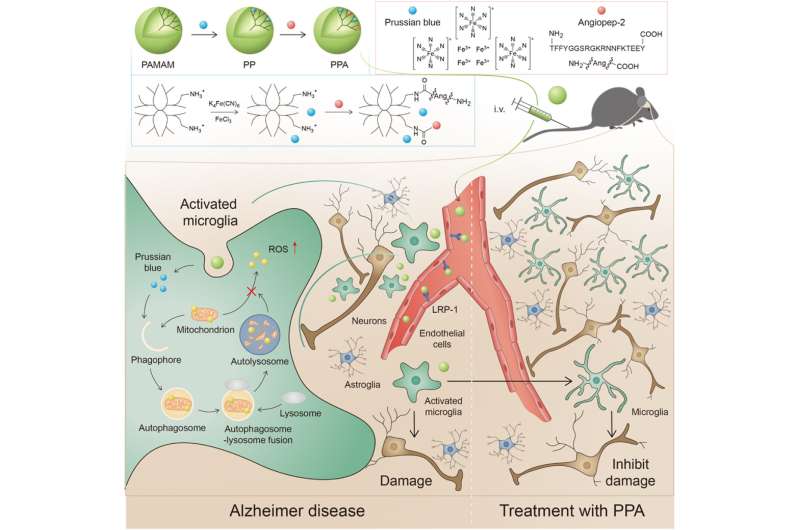Researchers develop blood-brain-barrier-permeable nanoparticles for Alzheimer's disease treatment

Alzheimer's disease (AD) is a complex neurodegenerative disease that leads to insidious deterioration of brain functions. Current treatments for AD that focus on inhibition of amyloid beta (Aβ) aggregation failed to show effectiveness in people with AD symptoms.
Strategies that synergistically exert neuroprotection and alleviation of oxidative stress could be a promising approach to correct the pathological brain microenvironment.
Now, a research team led by Dr. Yu Yin from the Shenzhen Institute of Advanced Technology (SIAT) of the Chinese Academy of Sciences has developed blood-brain-barrier-permeable nanoparticles for AD treatment based on selective mitophagy of microglia by restoration of mitochondrial function.
Related results were published in Biomaterials on Aug. 12.
"The hybrid nanoparticle platform enables high blood-brain barrier transport efficacy and removal of intracellular reactive oxygen species," said Dr. Yu.
The researchers achieved this by incorporating Angiopep-2 (ANG-2)-modified Poly (amidoamine) (PAMAM) with Prussian blue (PB) nanoparticles to increase the blood-brain barrier transport efficacy and circulation lifetime of PB with the assumption that the hybrid nanoparticles would synergistically scavenge the intracellular reactive oxygen species and modulate microglia to treat AD. The prepared hybrid nanoparticles are called PPA nanoparticles.
Through specifically labeling the biomarker for autophagy, the team confirmed that the synergistic effect of PPA nanoparticles for normalization of microenvironment was mainly because they could regulate the metabolism of microglia through activating mitophagy.
The results also showed that by suppressing hyperactive microglia, the Aβ deposition in the brain tissue also dropped significantly. As neuroinflammation, oxidative damage and Aβ deposition are important promoters of neuronal damage in AD, the improvement of the microenvironment in the brain tissue directly contributes to the inhibition of neuronal damage and the improvement of memory function of mice with AD.
"To the best of our knowledge, this is the first report to demonstrate PB's neuroprotective properties and restoration of mitochondrial function of microglia for AD treatment," said Dr. Yu.
The activation of microglia is regarded as an important skeptic of culprit of AD. The new findings have indicated that PPA nanoparticles can reverse the pathological activation of microglia.
"Our results suggest that this hybrid nanoparticles platform could become promising neuroprotective agents for the treatment of AD by inducing autophagy of microglia and correction of the brain microenvironment," said Dr. Zhong Gang, lead author of the study.
More information: Gang Zhong et al, Blood-brain barrier Permeable nanoparticles for Alzheimer's disease treatment by selective mitophagy of microglia, Biomaterials (2022). DOI: 10.1016/j.biomaterials.2022.121690
Journal information: Biomaterials
Provided by Chinese Academy of Sciences




















